Register Early & Save

Contact Your Senators
The Senate Appropriations Committee and its subcommittees are writing appropriation bills for the federal government FY26 budget now. Make sure that science remains adequately funded!
Read more
Field Medical Kits
Great for field season! Build your own medical kit tailored to various scenarios and needs, with equipment useful for self-care or to treat team members in remote locations.
Read more
SciComm Fellowships
Our Science Communication in the Parks program welcomes applications for 2025-26 fellows who will work with teams at U.S. national parks to develop high-quality communication products.
Read moreJournals & Publications
-
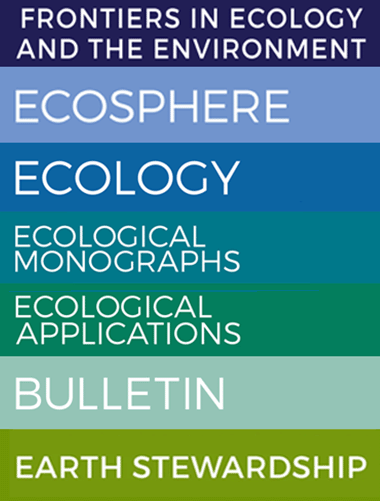
The Ecological Society of America has over 100 years of journal publishing history and offers some of the most widely read and cited journals in the field of ecology. The seven journals in our portfolio encompass a wide range of paper types to include an array of aims and scope of study, making them an important and accessible outlet for scientists, researchers, practitioners, professionals, citizen scientists, and others seeking to publish their work. ESA staff provide editorial support with our publishing partner, John Wiley & Sons, and several discounts towards publication in ESA journals are available from our publisher and from ESA. Publishing in ESA journals contributes to ESA programs for students, early career researchers, and underrepresented groups, and we thank our editors, reviewers, authors, and readers for their support.
-
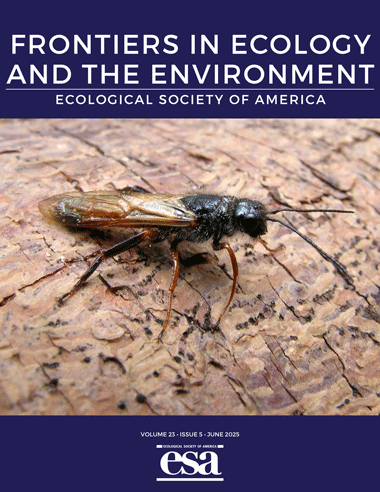
The global expansion of plantation forestry coupled with an increase in trade are escalating threats from invasive forest insects worldwide. Sirex noctilio, a wood-boring wasp endemic to Eurasia, has established populations in many regions outside of its native range and where pine trees are cultivated for commercial purposes. Its impacts and spread have encouraged international collaboration to develop pest management strategies and actions. However, the variable success among regions in controlling this invasive insect highlights the need for regional adaptation of pest management practices to account for potentially important regional differences. To improve the implementation and success of integrated pest management (IPM) programs, Stastny et al. propose an iterative process of considering several factors—biological variation, the abiotic environment, scale and capacity, and the regulatory and cultural context—in each region. This process should balance the anticipated efficacy of tactics against the greatest risks to the program in newly invaded regions, while enhancing resilience of existing programs over time.
-

Many wildlife species, such as grizzly bears (Ursus arctos horribilus), are “unmarked,” bearing no individually recognizable characteristics, thereby preventing easy application of common spatial mark–recapture or mark–resight methods. However, when a portion of the population is marked, for example, with ear tags or GPS collars, ecologists can apply spatial mark–resight models that borrow information from the marked sample to infer spatial density for the unmarked sample. In their article in the April issue of Ecosphere, Whittington et al. used simulations and empirical approaches to evaluate the efficacy of such generalized spatial mark–resight (gSMR) models applied to the grizzly bear. Simulation models confirmed the reliability of two different formulations of the novel gSMR model. This research demonstrates that the model could be applied to other cryptic, low-density, partially marked animals across the globe.
-
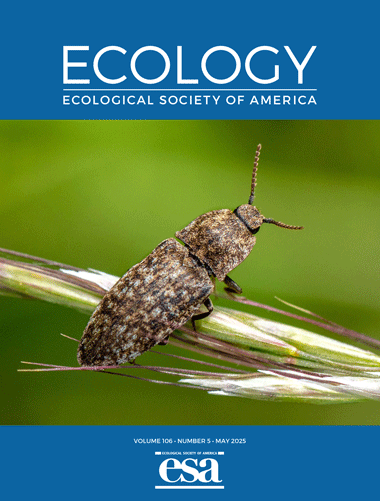
The May cover of Ecology shows an adult click beetle, Agrypnus murinus, a species common in grasslands of the northern hemisphere, sitting on a blade of grass. The photo was taken in May 2022 at the Jena Experiment field site, a long-term grassland biodiversity experiment. This beetle is one of many arthropods featured by Bröcher et al. in their data paper in the April issue of Ecology which compiles trait data for over 1,300 species, including coleopterans, arachnids, hemipterans, hymenopterans, isopods, myriapods, and orthopterans. The traits span feeding ecology, habitat requirements, flight capability, and size, offering a comprehensive resource for exploring arthropod functional roles in grassland ecosystems.
-
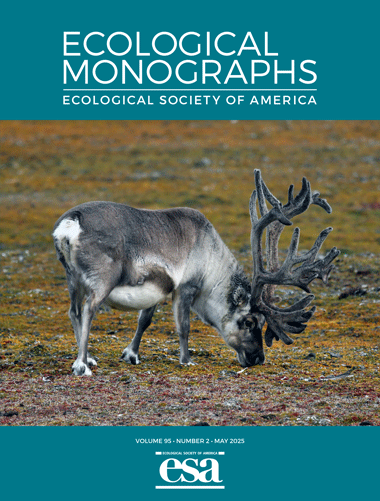
Changes in animal migration behavior are increasingly documented in response to rapid global change. The Svalbard reindeer (Rangifer tarandus platyrhynchus) is a partially migratory ungulate with studies reporting a decline in the proportion of migrants between 1998 and 2008. Inspired by empirical evidence from multiple partially migratory species, Liu et al. developed a theoretical model that highlights the key role of seasonal density dependence in shaping migratory propensity at population level. Their study is published in the February issue of Ecological Monographs. The May cover image shows a Svalbard reindeer foraging in Ny-Ålesund, Svalbard, Norway, photographed in August 2019.
-
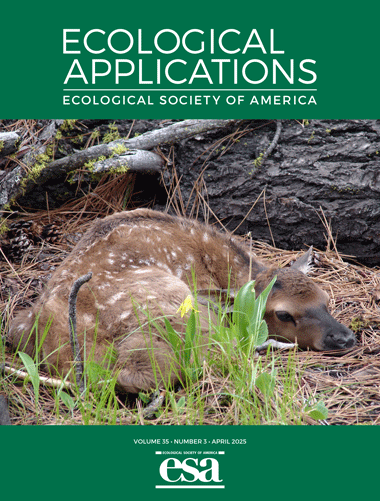
Pregnancy rates of large herbivores like North American elk (Cervus canadensis) are nutritionally mediated and can influence population performance. In their paper published in the March issue of Ecological Applications, Robatcek et al. developed a series of linked models for predicting variation in pregnancy rates among populations of elk as a function of foodscape use and availability. The study finds that pregnancy was influenced more strongly by foodscape heterogeneity than by absolute differences in forage availability among populations. The April issue's cover photograph features an elk calf, <24 hours old, hiding to avoid detection.
-
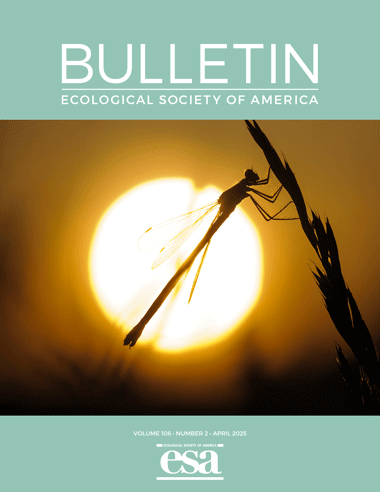
The April issue of the ESA Bulletin continues its focus on ecology education and communicating science with articles that highlight the benefits of a diverse ecology education, collaboration between students, educators, and scientists, and tips to increase a research team's productivity and effectiveness. As the record for society business, the April issue also includes reports of society actions, Resolutions of Respect, and an extensive Photo Gallery highlighting research published in the ESA journal portfolio.
-
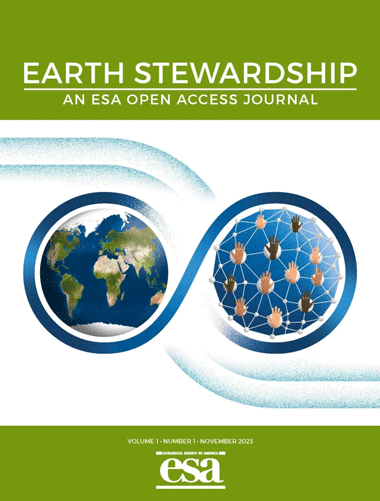
We are delighted to announce a call for submissions for Earth Stewardship. This exciting new Open Access journal, launched with our publishing partner, John Wiley & Sons, calls for a broad spectrum of scientifically and technologically innovative and groundbreaking contributions including cross-cultural perspectives from leading researchers, policymakers, traditional custodians of land and sea and indigenous communities. Earth Stewardship publishes applied and theoretical articles to promote a broad, intercultural, and participatory foundation for earth stewardship.
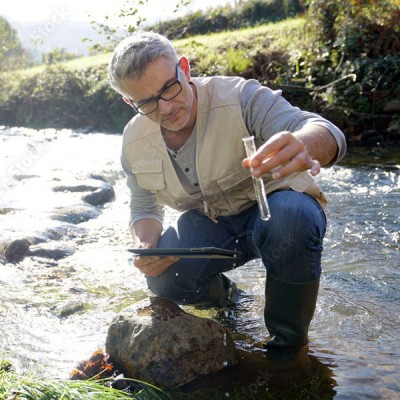
Professional Certification
Employers in all sectors value a credential that validates your skill as a professional. Learn more about ongoing changes to ESA certification and start your application today!
Read more
Opportunity Fund Donations
Make a difference and fund programs which empower, educate and embolden both the current and next generation of scientists in the vast field of ecology.
Read more
Next Year's Annual Meeting
The 2025 Annual Meeting will be held in Baltimore, Maryland. Select the following link and check out the theme, preliminary schedule, exhibitor opportunities and upcoming deadlines for proposals.
Read more